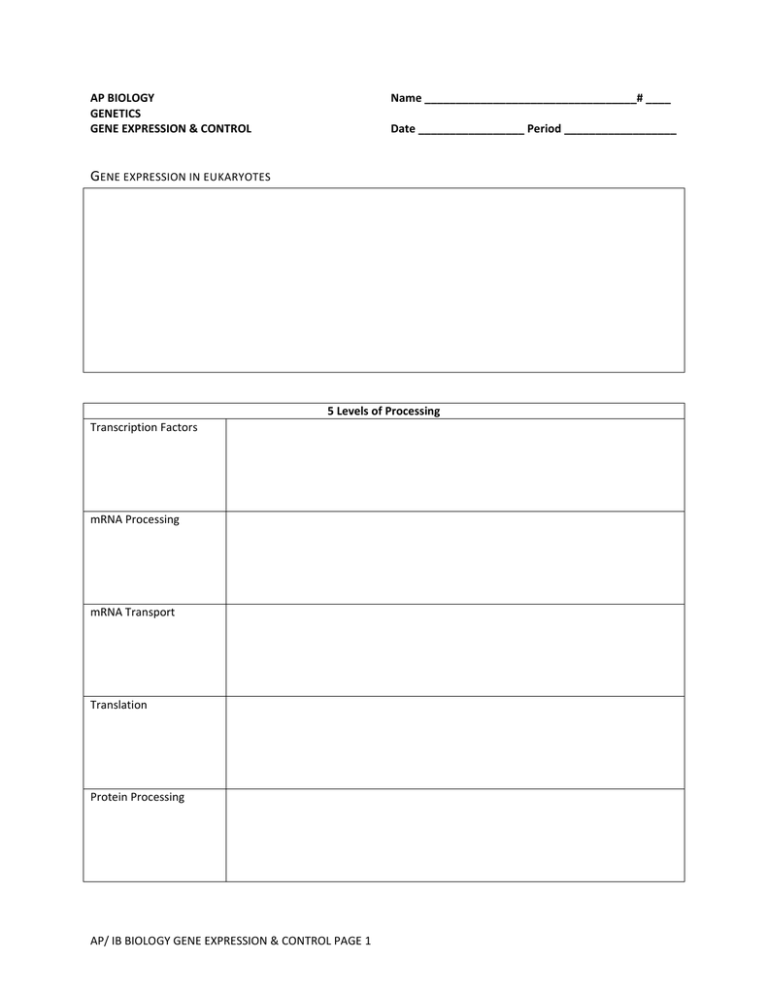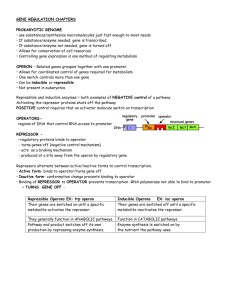operator D. stimulates gene expression
advertisement

AP BIOLOGY GENETICS GENE EXPRESSION & CONTROL Name __________________________________# ____ Date _________________ Period __________________ GENE EXPRESSION IN EUKARYOTES 5 Levels of Processing Transcription Factors mRNA Processing mRNA Transport Translation Protein Processing AP/ IB BIOLOGY GENE EXPRESSION & CONTROL PAGE 1 A FEW OUTCOMES OF EUKARYOTIC GENE CONTROL PROKARYOTIC GENE CONTROL Promoter Repressor Operon AP/ IB BIOLOGY GENE EXPRESSION & CONTROL PAGE 2 TRP OPERON AP/ IB BIOLOGY GENE EXPRESSION & CONTROL PAGE 3 LAC OPERON AP/ IB BIOLOGY GENE EXPRESSION & CONTROL PAGE 4 QUESTIONS AND LEARNING OBJECTIVES 1. Listed below are descriptions and examples of the different types of recombination in bacteria. Classify each type as: A) transformation B) transduction C) conjugation D) transposons ______ Bacteria assimilate genetic material from surroundings ______ Bacteria take up DNA from environment ______ Gene transfer from one bacterium to another via bacteriophage ______ Direct transfer of genes between two bacterial temporarily joined by sex pili ______ Jumping genes first described by Barbara McClintock ______ Pieces of DNA move from one location to another location in cell’s genome ______ A DNA segment is moved from one location to another ______ DNA is transferred from one bacterium to another by a virus ______ A plasmid is exchanged between two bacteria through a pilus ______ Bacterial strains A and B are growing together in a colony that has been infected with viruses. After a short period of time, a new strain of bacteria is detected that is very similar to strain A, but has a few characteristics of B. ______ The conversion of live R strain Streptococcus pneumoniae into S strain when heat-killed S strain is added to R strain ______ E. coli bacteria are induced to take up the pBLU plasmid 2. Match the description/function with the correct term. A. Corepressor genes with related functions C. Operon into several polypeptides E. Promoter G. Repressor ______ Regulated cluster of adjacent structural B. Operator D. Polycistronic mRNA F. Regulatory Genes H. Structural gene ______ Gene that codes for polypeptide ______ Transcript of several genes; translated ______ RNA segment between promoter & structural genes; controls access of RNA polymerase to structural gene ______ Specific protein that binds to operator and blocks transcription ______ Genes that code for repressor or regulators of other genes gene ______ RNA polymerase binding site ______ Molecule that binds to repressor protein; complex then binds to operator AP/ IB BIOLOGY GENE EXPRESSION & CONTROL PAGE 5 3. Explain how the trp operon works: a. If tryptophan is absent from the cell. b. If tryptophan is present in the cell 4. Explain how tryptophan acts as a corepressor. 5. Match these components of the lac operon with their functions. ______ β-galactosidase A. is inactivated when attached to lactose ______ cAMP-CAP complex B. codes for synthesis of repressor ______ lactose C. hydrolyzes lactose ______ operator D. stimulates gene expression ______ promoter E. repressor attaches here ______ regulator gene F. RNA polymerase attaches here ______ repressor G. acts as inducer that inactivates repressor ______ structural gene H. codes for an enzyme 6. Listed below are characteristics of repressible and inducible enzymes. Identify each of the following as true of Repressible or Inducible enzymes. ______ genes are switched off until a specific metabolite inactivates the repressor ______ genes are switched on until a specific metabolite activates the repressor ______ Generally function in anabolic pathways ______ Usually function in catabolic pathways ______ Pathway end product switches off its own production ______ Enzyme synthesis is switched on by the nutrient in used in the pathway AP/ IB BIOLOGY GENE EXPRESSION & CONTROL PAGE 6





